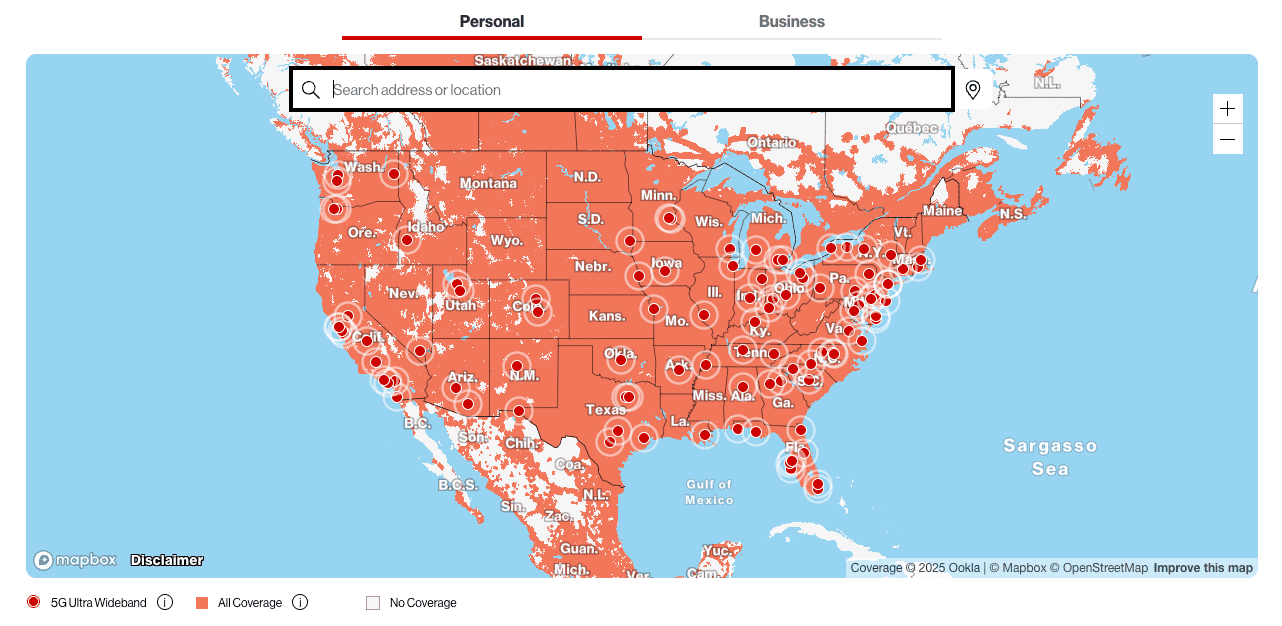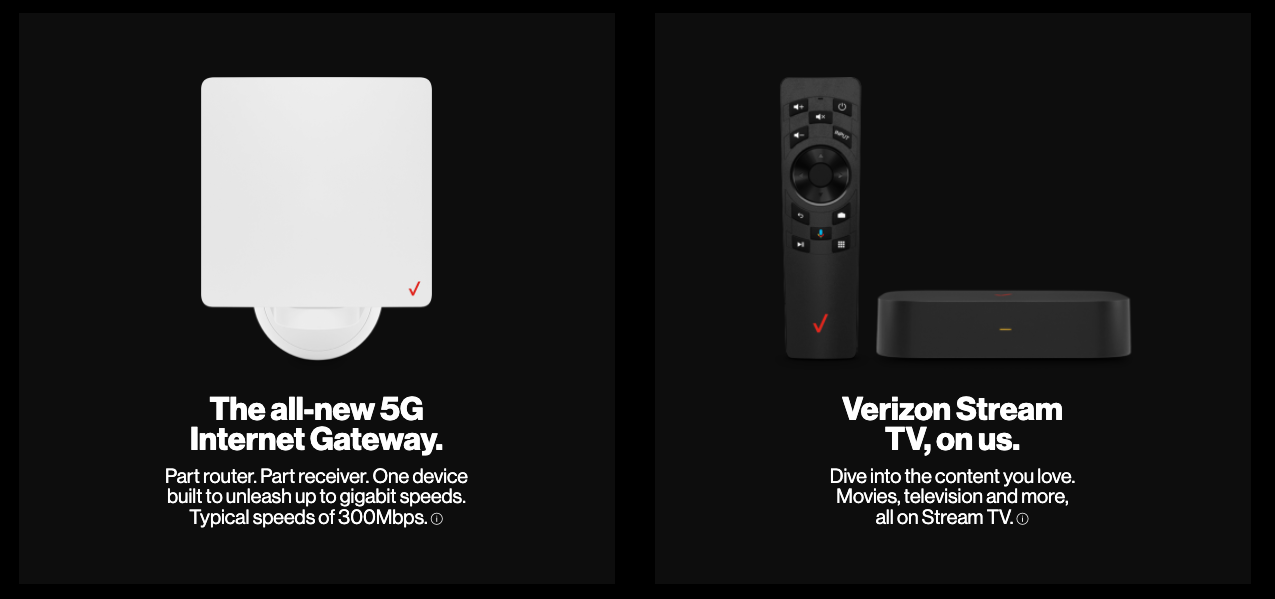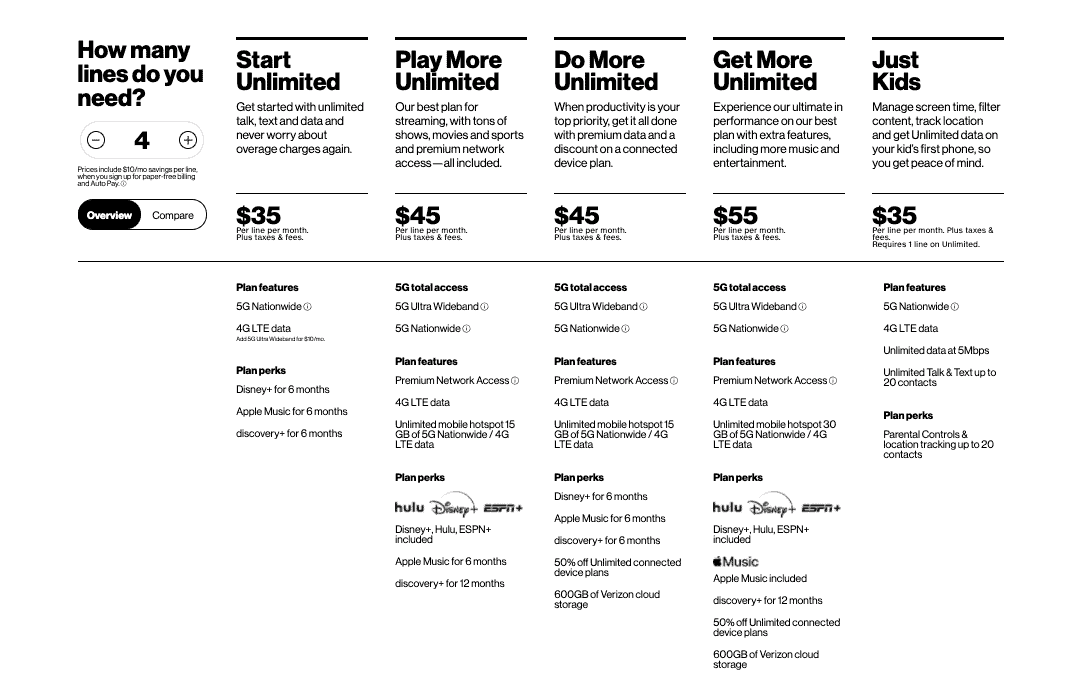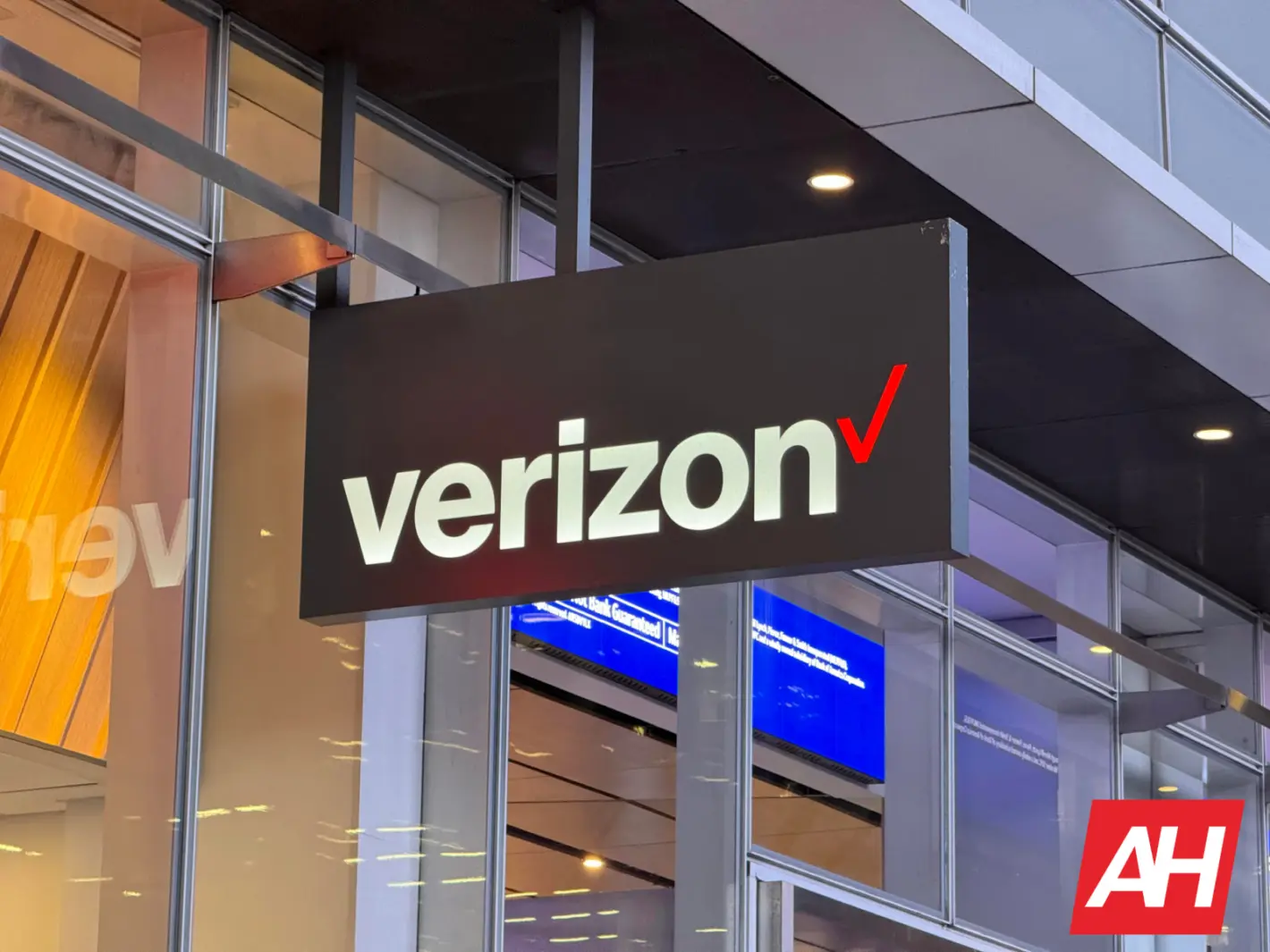5G first became available in 2020, and now, five years later, it’s available virtually everywhere in the United States. Verizon first built out its 5G network with mmWave before turning on Sub-6 and then adding C-Band. So depending on where you are located, you might see 5G, or 5G UW in your status bar. As Verizon classifies both mmWave and C-Band as “5G UW”, and Sub-6 is classified as regular old “5G”. Verizon’s 5G network is pretty incredible; we’ve seen speeds surpassing 2Gbps in our own testing.
As we noted in our “What is 5G” post, there are a few layers to 5G, which includes a low-band network, which is what is nationwide. And then there is mmWave, which is the ultra high-band network that offers the crazy gigabit speeds that you’ve seen in YouTube videos. Combining those two together will give users great speed and excellent coverage.
We all know that Verizon has 5G; if you’ve watched TV or YouTube in the past year, you’ve seen countless commercials about it. But how much does it cost you? Where is it available? And is it worth upgrading to a 5G phone right now? We’ll aim to answer those questions and much more here. This is everything you need to know.
Does my area have 5G?
Most likely.

Verizon’s 5G network covers around 230 million customers in over 2,700 cities, which covers the majority of the US. But let’s keep in mind that Verizon does have 5G and then 5G Ultra Wideband (which is their mmWave network). The latter doesn’t cover as many Americans, and you won’t find out indoors either. So do keep that in mind here.
As always, you can check out Verizon’s coverage map by clicking here.
As you can see in the map above, there are a small number of 5G Ultra Wideband networks across the country, mostly consisting of larger cities like Seattle, New York City, Albuquerque, Detroit, Denver, and a number of others.
5G vs 5G Ultra Wideband
As we have covered before, there is a difference in the two flavors of 5G that Verizon offers. 5G is essentially using the same spectrum as the current 4G LTE network. This is why if you have 5G in your area, you are likely seeing speeds similar to 4G LTE. That’s not unique to Verizon either; it’s the same case for AT&T and T-Mobile.
However, with 5G Ultra Wideband, you’re going to see much faster speeds. We’ve done some testing and have gotten over 2Gbps on Verizon on the UWB network. It uses mmWave, which is an ultra high-band spectrum, offering crazy speeds but pretty terrible coverage. The way coverage works is that the lower band spectrum offers better coverage but slower speeds, and the higher band has better speed but less coverage. This is why most carriers combine these two for 5G.
Additionally, if you are inside, you won’t get access to 5G Ultra Wideband. That is because the coverage is pretty weak and can’t penetrate through buildings. Heck, if there’s a tree in the way, you will get knocked off of the 5G UWB network or if the wind is too strong. Which is pretty funny since many people seem to think it can cause cancer. But that’s a rant for another time.
In the future, Verizon will be combining the 5G and 5G UWB networks, so you will get these gigabit speeds indoors, virtually anywhere. But that will take a few years, likely around 2025.
5G Ultra Wideband is available in these cities
As mentioned, 5G Ultra Wideband is available in a number of cities already; here’s the full list:
- Akron, OH
- Albuquerque, NM
- Anaheim, CA
- Ann Arbor, MI
- Arlington, TX
- Athens, GA
- Atlanta, GA
- Baltimore, MD
- Boise, ID
- Boston, MA
- Charlotte, NC
- Chicago, IL
- Cincinnati, OH
- Cleveland, OH
- Colorado Springs, CO
- Columbia, SC
- Columbus, OH
- Dallas, TX
- Dayton, OH
- Denver, CO
- Des Moines, IA
- Detroit, MI
- Durham, NC
- El Paso, TX
- Fort Wayne, IN
- Fremont, CA
- Fresno, CA
- Grand Rapids, MI
- Greensboro, NC
- Hampton Roads, VA
- Harrisburg, PA
- Hartford, CT
- Hoboken, NJ
- Houston, TX
- San Antonio, TX
- Indianapolis, IN
- Jacksonville, FL
- Jersey City, NJ
- Kansas City, MO
- Knoxville, TN
- Las Vegas, NV
- Little Rock, AR
- Los Angeles, CA
- Louisville, KY
- Memphis, TN
- Miami, FL
- Milwaukee, WI
- Minneapolis, MN
- Nashville, TN
- New Orleans, LA
- New York, NY
- Norfolk, VA
- Oklahoma City, OK
- Omaha, NE
- Orlando, FL (Sept 9)
- Panama City, FL
- Philadelphia, PA
- Phoenix, AZ
- Providence, RI
- Raleigh, NC
- Richmond, VA
- Riverside, CA
- Sacramento, CA
- Salt Lake City, UT
- San Diego, CA
- San Francisco, CA
- San Jose, CA
- Sarasota, FL
- Scranton, PA
- Sioux Falls, SD
- Spokane, WA
- St. Louis, MO
- St. Paul, MN
- St. Petersburg, FL
- Syracuse, NY
- Tacoma, WA
- Tampa, FL
- Tucson, AZ,
- Washington D.C.
C-Band is coming
Verizon announced at CES 2022 that it would be launching its C-Band network in over 1,700 cities, covering 100 million Americans by the end of January 2022. Verizon has not yet released a list of which cities will be getting C-Band.
C-Band is basically the mid-tier of 5G. It’s going to give you much faster speeds than 4G LTE offered, but not quite the same speeds as the mmWave network that is available in many downtown areas and at many arenas/stadiums.
C-Band launched on January 19, 2022, and Verizon has continued to build C-Band out nationwide.
Can I use 5G as my home internet?
We would recommend against using 5G as your ISP provider unless you get Verizon 5G Home. That is because the faster speeds are virtually impossible to get indoors, as we have already outlined. Which means you won’t be getting great speeds.

However, there is Verizon 5G Home. Verizon’s home internet service runs on a fixed 5G network. It costs $50 per month for existing Verizon Wireless customers and $70 for those that are not. This makes this very competitive with other ISPs out there like Cox, Comcast, AT&T, and even Verizon Fiber.
These are the cities where Verizon 5G Home is available right now:
- Birmingham, AL
- Phoenix, AZ
- Tucson, AZ
- Fremont, CA
- Los Angeles, CA
- Orange County, CA
- Riverside, CA
- Sacramento, CA
- San Diego, CA
- San Francisco, CA
- San Jose, CA
- Denver, CO
- Hartford, CT
- Jacksonville, FL
- Miami, FL
- Orlando, FL
- Pensacola, FL
- Sarasota, FL
- Tampa, FL
- Atlanta, GA
- Des Moines, IA
- Chicago, IL
- Fort Wayne, IN
- Indianapolis, IN
- Louisville, KY
- New Orleans, LA
- Detroit, MI
- Minneapolis, MN
- Saint Paul, MN
- Kansas City, MO
- St Louis, MO
- Charlotte, NC
- Greensboro, NC
- Raleigh, NC
- Omaha, NE
- Las Vegas, NV
- Niagara Falls, NY
- Cincinatti, OH
- Cleveland, OH
- Columbus, OH
- Dayton, OH
- Scranton, PA
- Memphis, TN
- Arlington, TX
- Dallas, TX
- Houston, TX
- San Antonio, TX
- Salt Lake City, UT
- Seattle, WA
- Tacoma, WA
- Milwaukee, WI
How fast can 5G be on Verizon?
Speeds on Verizon’s 5G network can vary drastically. On its nationwide 5G network, using Sub-6, you’ll get around 100Mbps to 300Mbps, depending on the area. Which doesn’t sound all that impressive, nor is it what Verizon and other carriers have been promising with 5G.
The speeds come from the mmWave network. We have done speed tests where we have gotten 1.8Gbps up to about 2.5Gbps. Now yes, that is pretty insane on a smartphone and probably overkill for most people, but it is going to be incredible to download games or seasons on Netflix, etc. Once mmWave is rolled out everywhere with Sub-6, you should consistently get over a gigabit of speed, even while indoors. But that will take a few years.
Why do I need 5G speeds?
Most people see 5G speed tests and wonder, “Why do I need that much speed on a phone?” Well, the question you should be asking is “Why not?”. 5G is mostly about speed but more about latency. And with carriers expanding beyond smartphones, the latency is going to be important for things like VR and autonomous driving. As they will be able to stream virtual reality, or give directions to your self-driving car instantly.
Don’t forget that we asked these same questions with 4G LTE and said that 3G was “fast enough”. Well, we now know that is definitely not true. Seeing as 3G topped out at around 5Mbps (or around 42Mbps if you were on T-Mobile with HSPA+). Imagine trying to watch YouTube at 5Mbps these days. Yeah, it wouldn’t be fun.
As the internet evolves, we need faster speeds, and that’s why 5G matters. While getting a gigabit of speed is a bit insane right now, it won’t be in the next 5-10 years as things evolve and take advantage of this speed. The biggest use-case for it right now is, of course, downloading Netflix movies and TV shows in seconds. And we do mean seconds.
Let’s just hope that carriers don’t go back to data caps and keep unlimited data. Otherwise, you’ll blow through that cap in no time.
What phones support 5G on Verizon?
Pretty much every phone that Verizon sells right now is 5G capable and will support both 5G and 5G Ultra Wideband. So any phone you buy from Verizon will work on its 5G network, and there’s nothing to worry about there.
The issues come with unlocked phones. A good number of unlocked phones do not support mmWave or Verizon’s 5G Ultra Wideband network. And that’s because Verizon is virtually the only carrier using mmWave right now (that will change in the coming months and years, though). So if you buy an unlocked 5G phone to use on Verizon, make sure that it has UWB, or you won’t get lightning-fast speeds from Verizon’s 5G Ultra Wideband network.
It will still work on Verizon’s network, you just won’t get those crazy insane speeds that everyone posts about. The Google Pixel 5 supports UWB, as well as the Galaxy S21 series and a number of other phones, which you can buy elsewhere.
Should I upgrade to get 5G now?
Our recommendation is no. Verizon’s nationwide 5G network is not that much faster than its 4G LTE network, and in some areas it is actually slower. And since you can only really use the 5G Ultra Wideband network while outside, it doesn’t make a lot of sense to upgrade solely for 5G.
Having said that, if you are upgrading, you might as well get a 5G phone. Especially if you are planning to keep it for a few years. But don’t let 5G be the sole reason why you upgrade to a new phone. It’s just not worth it right now. That will of course change in the future, as Verizon continues to build out its 5G network.
What Verizon plans support 5G?
All of Verizon’s plans include 5G connectivity. However, the entry-level plan – Start Unlimited – does not include 5G Ultra Wideband. But you can access it for $10 more per month. And at that point, you might as well upgrade to the Play More or Do More Unlimited plan, which is $10 more and includes 5G Ultra Wideband connectivity at no extra charge.
You’ll also note that the Just Kids plan doesn’t have 5G UWB connectivity at all. This is because it is a smaller plan, hence the $35 price tag, if you get four lines. Since speeds are capped at 5Mbps.

The best plan for 5G on Verizon is going to be the Play More or Get More Unlimited plan. Unless you’d rather have Verizon Cloud Storage included and plan to add Connected devices like smartwatches and tablets to your account. Play More and Get More Unlimited plans to get the Disney+ bundle included (that’s Disney+, Hulu, and ESPN+) and Discovery+ for 12 months. The Get More Unlimited plan includes Apple Music, 50% off unlimited connected device plans, and 600GB of Verizon Cloud Storage.
It’s also important to note here that you will need to “upgrade” your plan if you upgrade from a 4G LTE phone to a 5G phone. Even though the plan is essentially the same in terms of perks and price, it only adds 5G to your plan. It’s strange that you have to physically upgrade your plan on Verizon’s website when you upgrade your phone, but it’s pretty simple. So, if you upgrade to a 5G phone and wonder why you’re not getting 5G on Verizon, that is most likely why.
Update: Verizon has retired the plans above. While they are still available for those on those plans, there is a new set of plans as outlined below.
All of Verizon’s myPlan offerings include 5G. However, Unlimited Welcome only offers regular 5G (basically, Sub-6). While the Unlimited Plus and Unlimited Ultimate plans will offer you 5G Ultra Wideband, which includes C-Band and mmWave. So important to keep that all in mind.
Is Verizon 5G worth it in 2024?
It actually is. If you live in a big city or frequent areas that are pretty dense, getting a 5G phone and a 5G plan from Verizon will make a huge difference. Verizon’s C-Band is available in a lot of major cities, and you can easily get over 500Mbps download with C-Band, making it worthwhile. mmWave is mostly used in stadiums, downtown areas, malls, and such, where there are large crowds of people, so it’s not as ubiquitous, but it does offer some insanely fast speeds.
If you’re someone who lives out in the boonies or in the middle of nowhere, then you are probably fine sticking with 4G LTE or, at the very least, upgrading to the Unlimited Welcome plan, which has Sub-6 5G.

